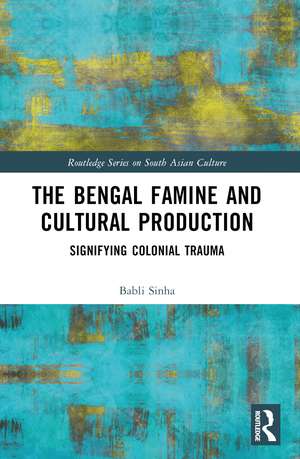The Bengal Famine and Cultural Production: Signifying Colonial Trauma: Routledge Series on South Asian Culture
Autor Babli Sinhaen Limba Engleză Paperback – 28 noi 2024
Official imperial narratives blamed the famine on natural disaster, war, exploitation by merchants, and incompetent local officials rather than members of the imperial government and have remained dominant in the global public imaginary until recent years. The authors and artists referenced in this study appealed to elite Bengali, South Asian, and international audiences to resist imperial narratives that minimized or erased suffering and instead encouraged relief efforts, promoted nationalist movements, maintained collective memory, innovated ethical forms of representation, and prompted systemic change. They were part of an established tradition of English in the subcontinent as the language of empire and cosmopolitanism but are not accessible, widely taught, or well-known. The direct encounter with suffering was and remains insufficient for prompting systemic change or even engagement, and yet, the recognition of trauma is crucial for personal and collective well-being. The cultural production of famine writers and artists sought to integrate the suffering and agency of the destitute into narratives of Bengali and South Asian identity and of the Second World War.
It is crucial to the Humanities to recognize this body of work as a cultural counter-discourse to the biopower of empire and to engage these texts as relevant to theories of trauma. The book will be of interest to researchers in the field of South Asian history, the history of the Bengal famine, South Asian Anglophone literature, twentieth century art history, and trauma theory.
| Toate formatele și edițiile | Preț | Express |
|---|---|---|
| Paperback (1) | 302.37 lei 6-8 săpt. | |
| Taylor & Francis – 28 noi 2024 | 302.37 lei 6-8 săpt. | |
| Hardback (1) | 1000.76 lei 6-8 săpt. | |
| Taylor & Francis – 11 iul 2023 | 1000.76 lei 6-8 săpt. |
Preț: 302.37 lei
Nou
Puncte Express: 454
Preț estimativ în valută:
57.86€ • 60.41$ • 47.78£
57.86€ • 60.41$ • 47.78£
Carte tipărită la comandă
Livrare economică 15-29 aprilie
Preluare comenzi: 021 569.72.76
Specificații
ISBN-13: 9781032370200
ISBN-10: 1032370203
Pagini: 166
Ilustrații: 8
Dimensiuni: 156 x 234 mm
Greutate: 0.31 kg
Ediția:1
Editura: Taylor & Francis
Colecția Routledge
Seria Routledge Series on South Asian Culture
Locul publicării:Oxford, United Kingdom
ISBN-10: 1032370203
Pagini: 166
Ilustrații: 8
Dimensiuni: 156 x 234 mm
Greutate: 0.31 kg
Ediția:1
Editura: Taylor & Francis
Colecția Routledge
Seria Routledge Series on South Asian Culture
Locul publicării:Oxford, United Kingdom
Public țintă
Academic and PostgraduateCuprins
Introduction; Chapter One: The Long Famine in The Bengal Tragedy and Famine and Rehabilitation in Bengal; Chapter Two: Emotion and Resistance in T.G. Narayan’s Famine Over Bengal; Chapter Three: Love as a Decolonial Framework in Freda Bedi’s Bengal Lamenting; Chapter Four: Trauma and Referentiality in Bhabani Bhattacharya’s Famine Novels; Chapter Five: Opacity and Witnessing in Ela Sen’s and Zainul Abedin’s Darkening Days; Chapter Six: The Recognition of Suffering in Chittaprosad’s Hungry Bengal; Chapter Seven: Activism and Restraint in the Famine Photography of Sunil Janah; Chapter Eight: "Innumerable Wounds": The Marked Bodies of Somnath Hore; Epilogue: Continuities
Notă biografică
Babli Sinha is Associate Professor of English and Director of Media Studies at Kalamazoo College, USA. She is the author of Cinema, Transnationalism, and Colonial India: Entertaining the Raj (2013) and editor of South Asian Transnationalisms: Cultural Exchange in the Twentieth Century (2012), also published by Routledge.
Descriere
This book analyses the various modes of representation used by Anglophone authors and artists in response to the Bengal Famine of 1943. It will be of interest to researchers in the field of South Asian history, the history of the Bengal famine, South Asian Anglophone literature, twentieth century art history, and trauma theory.




